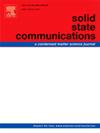在电场作用下,磁晶各向异性对CrI3单层内skyrmions稳定性的影响
IF 2.1
4区 物理与天体物理
Q3 PHYSICS, CONDENSED MATTER
引用次数: 0
摘要
我们采用密度泛函理论(DFT)和蒙特卡罗模拟相结合的方法来探索应用面外电场如何影响单层三碘化铬(CrI3)的磁性能。在T=0 K时,我们的模拟表明,垂直于晶体平面施加2 V/nm的电场,以及适度的磁场,可以自发地诱导出天空电子基态。此外,还系统地讨论了磁晶各向异性和Dzyaloshinskii-Moriya相互作用对操纵外磁场产生skyrmions的影响。在存在和不存在磁晶各向异性(Ka)的情况下,我们发现天幕在外加磁场的明显和明确的值下出现和消失(B)。此外,我们还研究了B对skyrmions属性的影响,如skyrmions数量(Nsky)和大小(d)。最后,我们绘制了一张图,显示了CrI3在不同温度和磁场强度下的不同磁态。总的来说,我们发现当考虑磁晶各向异性常数时,在CrI3中模拟skyrmions在能量上更有利。本文章由计算机程序翻译,如有差异,请以英文原文为准。
Impact of magnetocrystalline anisotropy on the stability of skyrmions within a CrI3 monolayer under the application of an electric field
We employ a combined approach of density functional theory (DFT) and Monte Carlo simulations to explore how the magnetic properties of a single layer of chromium tri-iodide (CrI3) are influenced by the application of an out-plane electric field. At T=0 K, Our simulations suggest that for an electric field of 2 V/nm applied perpendicularly to the crystal plane, along with a moderate magnetic field, spontaneously induces a skyrmionic ground state. Furthermore, the dependence of magnetocrystalline anisotropy and Dzyaloshinskii-Moriya interaction on the creation of skyrmions by manipulation of the external magnetic field is systematically discussed. In the presence and absence of magnetocrystalline anisotropy (K), we found that skyrmions emerge and vanish at distinct and well-defined values of the applied magnetic field (B). In addition, we examined the impact of B on the skyrmions properties, such as the skyrmion number (N) and size (d). Finally, we created a map showing the different magnetic states of CrI3 at various temperatures and magnetic field strengths. Overall, we found that simulating skyrmions in the CrI3 is energetically more favorable when magnetocrystalline anisotropy constant is considered.
求助全文
通过发布文献求助,成功后即可免费获取论文全文。
去求助
来源期刊

Solid State Communications
物理-物理:凝聚态物理
CiteScore
3.40
自引率
4.80%
发文量
287
审稿时长
51 days
期刊介绍:
Solid State Communications is an international medium for the publication of short communications and original research articles on significant developments in condensed matter science, giving scientists immediate access to important, recently completed work. The journal publishes original experimental and theoretical research on the physical and chemical properties of solids and other condensed systems and also on their preparation. The submission of manuscripts reporting research on the basic physics of materials science and devices, as well as of state-of-the-art microstructures and nanostructures, is encouraged.
A coherent quantitative treatment emphasizing new physics is expected rather than a simple accumulation of experimental data. Consistent with these aims, the short communications should be kept concise and short, usually not longer than six printed pages. The number of figures and tables should also be kept to a minimum. Solid State Communications now also welcomes original research articles without length restrictions.
The Fast-Track section of Solid State Communications is the venue for very rapid publication of short communications on significant developments in condensed matter science. The goal is to offer the broad condensed matter community quick and immediate access to publish recently completed papers in research areas that are rapidly evolving and in which there are developments with great potential impact.
 求助内容:
求助内容: 应助结果提醒方式:
应助结果提醒方式:


